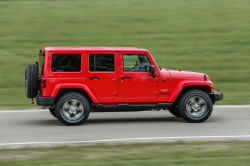
— A Jeep Wrangler radiator sludge lawsuit alleges the engines circulate sand through the cooling systems, causing the sand to settle in the radiators, oil cooling systems and heater cores. This allegedly creates sludge that blocks vital heating and cooling systems.
The proposed 2012-2017 Jeep Wrangler class-action lawsuit says the two lead plaintiffs suffered from heater problems that cost each plaintiff more than $1,000 to repair.
Both customers say their Jeep Wranglers were defective when they were shipped from the plant due to leftover sand in the cylinder heads. The sand allegedly travels through the systems and block vital components related to the HVAC systems.
Because sand shouldn't be there in the first place, routine maintenance allegedly does nothing to fix the alleged damage to the Pentastar engines and radiators. It's a problem Jeep owners have complained about for years.
The Texas owner of a 2012 Wrangler said there was no heat on the driver's side of the vehicle, so the owner checked the coolant.
"I checked my overflow tank and found about 3" of sand in the bottom. The service manager at the Jeep dealership said he did not have a recall, campaign or service bulletin on this and it would not be covered by Jeep. He said he'd not heard of the issue, but when he asked fellow service managers they had heard of it in older Wranglers. This is a pretty outrageous issue if you ask me. Nobody but Jeep dealers have serviced the vehicle, so where would significant amounts of sand-like residue come from to get into the cooling system?"
Another Jeep owner says taking the SUV back to dealers for heating problems has turned into a bad habit.
"I will be bringing in my Jeep for the third time to have the heat fixed. The passenger side heat feels warmer than the drivers side. After having my Jeep for six days, they ended up replacing the heater core (again!) and flushing the coolant to rid the system of any casting sand." - 2012 Jeep Wrangler owner / Eureka, Missouri
And the owner of a 2013 Jeep Wrangler complained the coolant was an abnormal color when the SUV had only 28,000 miles.
"The vehicle was taken to the dealer to get a coolant flush where it was diagnosed that there was casting sand in the coolant. The vehicle was repaired; however, upon returning the vehicle home, the contact inspected the coolant system and noticed that it had been contaminated by sand particles."
The Wrangler lawsuit alleges the only fix is to replace the engines to get rid of damage from sand in the cylinder heads.
A similar Wrangler class-action lawsuit was filed in June 2017 that alleges leftover engine casting sand causes sludge that blocks the radiators.
The Jeep Wrangler radiator sludge lawsuit was filed in the U.S. District Court for the Southern District of New York - Malizia et. al. v. FCA US, LLC.
The plaintiffs are represented Greg Coleman Law PC, Simmons Hanly Conroy LLC, and Whitfield Bryson & Mason LLP.




